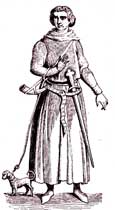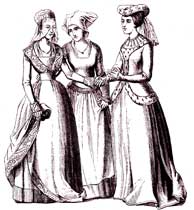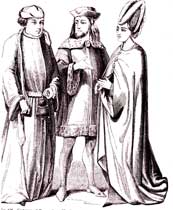Medieval Fashion
During the history of mankind, fashion was always a subject of controversy, and Medieval fashion followed the rule. It is a known fact that the Great Charlemagne did not like luxury in daily life. His household officers did not dare to show themselves in any clothes but those made of leather, wool or cloth. For had they made their appearance dressed in silk and ornaments, he would have sharply reproved them. However he used to make the most magnificent display on the occasions of political or religious festivals, when the imperial dignity with which he was invested required pompous ceremonial and richness of attire.
During the reign of the other Carolingian kings, amidst political troubles, internal wars, and social disturbances, people had neither time or inclination for inventing anything dress related, so the Medieval fashion hardly changed. In the late 9th Century, in France for example, the dress had undergone only minor changes since the time of Charlemagne, and the influence of Roman tradition, especially on festive occasions, was still felt in the dress of the nobles.

Royal Medieval Clothing
The dress of the two sexes during the 10th century did not change much either. The elegant appearance of the women garments recalls that of the Greek and Roman women. Their dresses were at times so tight as to display all the elegance of their form, whilst at others they were made so high as to completely cover the neck (cottes-hardies). The cotte hardie, which has at all times been part of the dress of the French women, and which was frequently worn by men, was a long tunic reaching to the heels, fastened in at the waist and closed at the wrists. Queens, princesses, and ladies of the nobility wore in addition a long cloak lined with ermine, or a tunic with or without sleeves. Often, their dress consisted of two tunics, and of a veil, which was thrown over the head and fell down before and behind, thus entirely surrounding the neck.
Overall, no important change was made in the Medieval fashion before the end of the 11th century. The ordinary dress made of thick cloths and of coarse woolen stuffs was very strong and durable, and not easily spoiled. And it was usual for clothes, especially those worn on festive occasions and at ceremonials, to be handed down as heirlooms from father to son, to the third or fourth generation.
The Normans, who came from Scandinavia towards the end of the 10h century, A.D. 970, with their short clothes and coats of mail, at first adopted the dress of the French. In the following century, having found the Saxons and Britons in England clad in the garb of their ancestors, slightly modified by the Roman style, they began to make great changes in their manner of dressing. They more and more discarded the Roman fashions, and assumed a fashion similar to that in France in the same period.

Noble Medieval Clothing
13th century
In the 12th century, the women of nobility wore a sort of cap made of linen, with lappets hanging down over the shoulders. The robe was fastened round the waist, with long bands attached to the sleeves near the wrists. They also used the long cloak, and the closed shoes which had begun to be made pointed. The men wore similar garments, with the robe descending only to the instep, and the belt with no hangings in front. Women, in addition to their head-dress, often wore a broad band, which was tied under the chin, and gave the appearance of a kind of frame for the face. Both sexes wore colored bands on their shoes, which were tied round the ankle like those of sandals, and showed the shape of the foot.
The Crusades gave rise to the general use of the purse, which was suspended to the belt by a cord of silk or cotton, and sometimes by a metal chain. At the time of the Holy Wars, it had became an emblem characteristic of pilgrims, who, before starting for Palestine, received from the hands of the priest the cross, the pilgrim's staff, and the purse.
In the 13th century, in the times of Louis IX, the Medieval fashion considerably changed when the surcoat was introduced. It was at first a garment worn only by women, but it was soon adopted by both sexes. It was originally a large wrapper with sleeves, and was thrown over the upper part of the robe (cotte), hence its name, from French, sur-cotte (over the cotte). Very soon it was made without sleeves, so the under garment, made of a more costly material, might be seen. In order that the motion of the limbs might not be interfered with, the surcoat was raised higher above the hips, and the arm-holes were made very large. From this period gowns with tight bodices were generally adopted. The women wore over them a tight jacket, reaching to a little below the hips, often trimmed with fur when the gown was richly ornamented. Also the fur was richly ornamented itself when the gown was plain. At the end of the 13th century luxury was at his height at the Court of France. Moreover, the magnificence and display was not confined to the Court, but it extended to the bourgeois class.

14th century Clothing:
Bourgeoise, Peasant-woman,
And Noble Lady
In the 14th century France, the men fashion, especially that of the young courtiers, took a turn for ridiculous and extravagant taste. According to the monks who edited the "Grande Chronique de St. Denis" in 1346, at the time of the Battle of Crécy, there was much impropriety in dress, and this extended throughout the whole of France. Some had their clothes so short and so tight that it required the help of two persons to dress and undress them. Others had their head-dresses and sleeves reaching to the ground, some had tippets of one cloth, others of another. Considering all this, they concluded, it is not surprising if God employed the King of England as a scourge to correct the excesses of the French people. Contemporary writers, among them Pope Urban V and King Charles V, inveigh against the poulaines, the shoes considered correct in fashion only when they measured at list double the length of the foot, and ornamented in the most fantastical manner.
Women dress, on the contrary, owing to a strenuous effort towards a dignified and elegant simplicity, became of such character that it combined all the most approved fashions of former periods. Without positively differing in style from that of the previous epoch, as it was composed of similar elements, was nevertheless to be distinguished by a degree of elegance unknown until then. The coat, or under garment, which formerly only showed itself through awkwardly-contrived openings, now displayed the harmonious outlines of the body, thanks to the large openings in the overcoat. The surcoat, kept back on the shoulders by two narrow bands, became a sort of wide and trailing skirt which draped the lower part of the body. The external corset was invented, which was a kind of short mantle, falling down before and behind without concealing any of the fine outlines of the bust. It was generally made of fur in winter, and of silk in summer.
The miniatures of this period are showing the gracefulness of the Medieval clothing, heightened by the colors employed, and we can understand what variety and what richness of effect the Medieval fashion could display without departing from the most rigid simplicity. The fashion of wearing false hair continued in great favor during the middle of the 14th century. The hair was being parted from the forehead to the back of the head in two equal masses, and waived over the ears. Nets were again adopted.

Merchant, Noble, And
A Lady From The Court
At the beginning of the 15th century men's dress was still very short. It consisted of a kind of tight waistcoat, fastened by tags, and of very close fitting breeches, which displayed the outlines of the person wearing them. In order to appear wide at the shoulders artificial pads were worn. The sleeves were slashed, the shoes armed with long metal points, and the conical hat, with turned-up rim, was ornamented with gold chains and various jewels.
The ladies, during the reign of Charles VI, still wore long trains to their dresses, which they carried tucked up under their arms, unless they had pages or waiting-maids. The tendency, however, was to shorten the inconvenient trains, as well as the long hanging and embroidered or fringed sleeves. Becoming shorter, ladies' dresses were trimmed in the most costly manner. Their head-dress consisted on very large rolls, surmounted by a high conical bonnet. It was at this period that they began to uncover the neck and to wear necklaces.
The Medieval fashion continued to evolve towards shortened clothing, and according to the chronicler Monstrelet, in 1487, ladies ceased to wear trains. About this time, too, men took to wearing shorter clothes than ever, having them to fit tightly to the body. The sleeves of their coats were slit open so as to show their fine white shirts. Knights and squires wore silk or velvet doublets. And almost everyone, especially at Court, wore the long pointed shoes. Under Charles VIII, the mantle, trimmed with fur, was open in front, its false sleeves being slit up above in order to allow the arms of the under coat to pass through. The cap was turned up. The breeches were made tight-fitting. The shoes with poulaines were superseded by a kind of large padded shoe of black leather, round or square at the toes. The women continued to wear conical caps of great height, covered with immense veils. Their gowns were made with tight-fitting bodies, displaying the outlines of the body.
Under Louis XII, a head-dress was invented for Queen Anne . It consisted of strips of velvet or of black or violet silk over other bands of white linen, which encircled the face and fell down over the back and shoulders. The large sleeves of the dresses had a kind of turned-over borders, with trimmings of enormous width.
Men adopted short tunics, plaited and tight at the waist. The upper part of the garments of both men and women was cut in the form of a square over the chest and shoulders, as most figures are represented in the pictures of Raphael and contemporary painters.
The last major change in the Medieval fashion is a result of the expedition of Charles VIII of France in Italy, which led to the introduction of Italian fashion. Although it did not differ much from the already adopted fashion, the Italian fashion exhibited better taste and a greater amount of elegance.
